CAA News Today
New in caa.reviews
posted by CAA — Apr 21, 2017
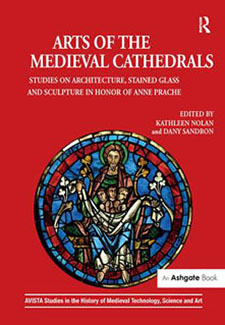 Evelyn Staudinger reviews Arts of the Medieval Cathedrals: Studies on Architecture, Stained Glass and Sculpture in Honor of Anne Prache, edited by Kathleen Nolan and Dany Sandron. The essays “honor the Sorbonne professor’s rich contributions to medieval art and architecture.” Covering a wide variety of topics, “the editors and authors have done a fine job celebrating Prache’s great intellectual acumen, diplomatic gifts, and warmth as a human being, while leaving behind erudite ‘memories’ and a wealth of new ideas.” Read the full review at caa.reviews.
Evelyn Staudinger reviews Arts of the Medieval Cathedrals: Studies on Architecture, Stained Glass and Sculpture in Honor of Anne Prache, edited by Kathleen Nolan and Dany Sandron. The essays “honor the Sorbonne professor’s rich contributions to medieval art and architecture.” Covering a wide variety of topics, “the editors and authors have done a fine job celebrating Prache’s great intellectual acumen, diplomatic gifts, and warmth as a human being, while leaving behind erudite ‘memories’ and a wealth of new ideas.” Read the full review at caa.reviews.
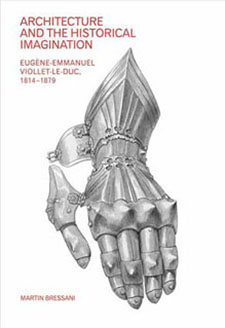 Jessica Basciano examines Architecture and the Historical Imagination: Eugène-Emmanuel Viollet-le-Duc, 1814–1879 by Martin Bressani. Viollet-le-Duc is “the nineteenth-century French architect, restorer, and theorist whose numerous and diverse activities continue to enthrall and perplex historians.” Although the “book’s complex arguments could be made clearer by offering more straightforward exposition,” “Bressani’s intellectual biography stands out in the landscape of Viollet-le-Duc studies because it offers a unified narrative based on the distinctive premise that the architect was motivated consistently by a form of pathological mourning.” Read the full review at caa.reviews.
Jessica Basciano examines Architecture and the Historical Imagination: Eugène-Emmanuel Viollet-le-Duc, 1814–1879 by Martin Bressani. Viollet-le-Duc is “the nineteenth-century French architect, restorer, and theorist whose numerous and diverse activities continue to enthrall and perplex historians.” Although the “book’s complex arguments could be made clearer by offering more straightforward exposition,” “Bressani’s intellectual biography stands out in the landscape of Viollet-le-Duc studies because it offers a unified narrative based on the distinctive premise that the architect was motivated consistently by a form of pathological mourning.” Read the full review at caa.reviews.
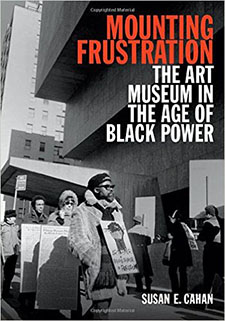 Anne Monahan reads Mounting Frustration: The Art Museum in the Age of Black Power by Susan E. Cahan. Framing her review with a discussion of recent police shootings of unarmed African American males and subsequent artists’ responses, Monahan presents Cahan’s “finely grained history of the New York art establishment’s attempts circa 1970 to reckon with African American representation.” Utilizing “close readings of archival documents, interviews, and secondary sources,” Cahan shows how demands by activists “conditioned the museums’ exhibition and hiring practices for decades thereafter.” Read the full review at caa.reviews.
Anne Monahan reads Mounting Frustration: The Art Museum in the Age of Black Power by Susan E. Cahan. Framing her review with a discussion of recent police shootings of unarmed African American males and subsequent artists’ responses, Monahan presents Cahan’s “finely grained history of the New York art establishment’s attempts circa 1970 to reckon with African American representation.” Utilizing “close readings of archival documents, interviews, and secondary sources,” Cahan shows how demands by activists “conditioned the museums’ exhibition and hiring practices for decades thereafter.” Read the full review at caa.reviews.
CAA Members Win NEH Summer Stipends
posted by CAA — Apr 13, 2017
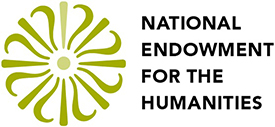 On March 29, the National Endowment for the Humanities (NEH) announced funding for 208 humanities projects totaling $21.7 million. These grants include programs that support international collaboration, engage students in interdisciplinary courses, and help veterans.
On March 29, the National Endowment for the Humanities (NEH) announced funding for 208 humanities projects totaling $21.7 million. These grants include programs that support international collaboration, engage students in interdisciplinary courses, and help veterans.
Among the recipients are the following CAA members, all of whom received a $6,000 Summer Stipend to work on their various research projects:
- Marie-Stéphanie Delamaire of the Winterthur Museum, Garden, and Library in Winterthur, Delaware, for “Diderot and d’Alembert’s Encyclopedia and the Color Printing Revolution: A Translation and Critical Study”
- Jennifer Germann of Ithaca College in Ithaca, New York, for “A Study of the Portrait of Dido Elizabeth Belle and Lady Elizabeth Murray, an 18th-century British Artwork”
- Laura Morowitz of Wagner College in Staten Island, New York, for “Art Exhibitions in Vienna, Austria, during the Nazi Occupation”
- Allie Terry-Fritsch from Bowling Green State University in Bowling Green, Ohio, for “Cosimo de’Medici, Fra Angelico, and the Public Library of San Marco”
- Anne Verplanck of Pennsylvania State University in Harrisburg for “The Business of Art: Transforming the Graphic Arts in an Age of Mechanical Reproduction”
These awards come just weeks after President Donald J. Trump’s administration released a budget proposal calling for the elimination of the NEH, the National Endowment for the Arts, the Department of Education’s international education programs, the Institute for Museums and Library Services, and the Woodrow Wilson International Center for Scholars.
Our attention now turns to Congress, which can fund these programs despite the administration’s proposals. We have been heartened that these programs—which have been supported by presidents of both parties—have seen growing support in Congress in recent years. Indeed, over the past two years, the Republican-controlled Congresses have supported increases for the NEH.
Institutional News
posted by CAA — Apr 12, 2017
Read about the latest news from CAA’s institutional members.
Institutional News is published every two months: in February, April, June, August, October, and December. To learn more about submitting a listing, please follow the instructions on the main Member News page.
April 2017
The Kansas City Art Institute in Missouri has accepted a $10 million gift to build a state-of-the-art student residence hall on campus. The visionary gift, made by an anonymous donor via the Greater Kansas City Community Foundation, will be used as the catalyst for a plan to create a new residence hall, dining facility, student services, and studios for academic programs—all of which will be designed specifically for the contemporary student in art and design.
The Metropolitan Museum of Art in New York announced its adoption of a new policy: all images of public-domain artworks in the museum’s collection are now available for free and unrestricted use. This updated policy uses the Creative Commons Zero designation and updates the Met’s 2014 Open Access for Scholarly Content initiative.
The Newark Museum in Newark, New Jersey, has been awarded a Bank of America Art Conservation Project grant for the conservation of the 1871 oil painting The Arch of Titus by George Peter Alexander Healy, Frederic Edwin Church, and Jervis McEntee. The grant program enables nonprofit museums throughout the world to conserve historically or culturally significant works of art that are in danger of deterioration.
The Pennsylvania Academy of the Fine Arts in Philadelphia has accepted a $350,000 grant from the Connelly Foundation for advancing the museum’s community educational outreach. The new Connelly Foundation Community Education Center, located in the academy’s historic landmark building at 118 North Broad Street, will host many of the academy’s ongoing programs for students, educators, families, and adults and be used for rotating exhibitions of community artwork, giving the school’s diverse audiences a voice within the museum.
The Winterthur Museum, Garden, and Library in Winterthur, Delaware, has accepted a new bequest commitment in furniture conservation. The newly endowed position will be named the Elizabeth Terry Seaks Furniture Conservator, in honor of the late mother of Terry G. Seaks, a respected collector and economist who made the position possible.
CAA Presents a Fair Use Workshop in Richmond
posted by CAA — Apr 10, 2017
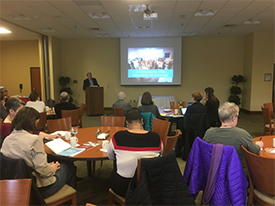
Peter Jaszi speaks to participants at a fair use workshop in Richmond, Virginia, March 24, 2017.
On Friday, March 24, the University of Richmond Museums, Virginia, hosted a CAA Fair Use Workshop, co-sponsored with the Virginia Museum of Fine Arts Statewide Program, and made possible with a grant from the Andrew W. Mellon Foundation. Elizabeth Schlatter, CAA Vice President for the Annual Conference, and Deputy Director and Curator of Exhibitions at the University of Richmond Museums, led the planning effort to bring over 40 artists, museum professionals, archivists, professors, librarians, and communications experts to the daylong workshop.
The program was led by Hunter O’Hanian, CAA’s Executive Director, and Peter Jaszi, Professor of Law at American University, and one of the two lead principal investigators on the project. After a round of introductions by attendees, Jaszi began the day with an introduction to the doctrine of fair use, followed by a presentation by O’Hanian about CAA’s four-year fair use initiative and the methodology employed to develop the Code of Best Practices in Fair Use for the Visual Arts. The workshop continued with a focus on fair use in art museums, including when it can be invoked in exhibition projects, publishing, and online activities. During a working lunch, Jaszi and O’Hanian led discussions on reliance on fair use in teaching, publishing, and making art, and concluded the day with a discussion about fair use in libraries and archives.
Catherine G. OBrion, the Librarian-Archivist at the Virginia State Law Library, wrote afterwards, “I have a much better understanding of the legal standing of fair use, its intent, and how I can defend relying on it to my in-house counsel and others….One of the most useful workshops I’ve attended.” The workshop was followed by a reception at the University Museums for all CAA members in the local area.
CAA executive director O’Hanian also met with two University of Richmond classes the day before, one a museum studies seminar and the other a class on contemporary art and theory. The undergraduates benefited from O’Hanian’s advice on curating exhibitions, organizing public programs, surviving and thriving as a visual artist, and applying for artists’ residency programs.
People in the News
posted by CAA — Apr 07, 2017
People in the News lists new hires, positions, and promotions in three sections: Academe, Museums and Galleries, and Organizations and Publications.
The section is published every two months: in February, April, June, August, October, and December. To learn more about submitting a listing, please follow the instructions on the main Member News page.
April 2017
Academe
Ira Goldberg, executive director of the Art Students League in New York, has resigned from his post.
Cordula Grewe has accepted a position as associate professor with tenure in the Department of Art History at Indiana University Bloomington, where she will teach European art between 1700 and today.
Alex Kitnick has been given the title of Brant Foundation Fellow in Contemporary Arts at Bard College’s Center for Curatorial Studies in Annandale-on-Hudson, New York.
Jonathan Morgan has become an adjunct professor of art at Lone Star College in the Woodlands, Texas.
Sheila Rae Neal has been named adjunct instructor at Munson-Williams-Proctor Arts Institute in Utica, New York.
Jennifer Rissler has been appointed dean and vice president of academic affairs at the San Francisco Art Institute in California.
Museums and Galleries
Esther Bell, previously curator in charge of European paintings at the Fine Arts Museum of San Francisco in California, has been named Robert and Martha Berman Lipp Senior Curator for the Sterling and Francine Clark Art Institute in Williamstown, Massachusetts.
Makeda Best, formerly assistant professor in visual studies at the California College of the Arts in Oakland and San Francisco, California, has been named Richard L. Menschel Curator of Photography at the Harvard Art Museums in Cambridge, Massachusetts.
Connie H. Choi, formerly assistant curator of American art at the Brooklyn Museum in New York, has been appointed associate curator of the permanent collection at the Studio Museum in Harlem, also in New York.
Joey Orr, formerly Andrew W. Mellon Postdoctoral Curatorial Fellow at the Museum of Contemporary Art in Chicago, Illinois, has been appointed Andrew W. Mellon Assistant Curator for Research for the Spencer Museum of Art at the University of Kansas in Lawrence.
James Merle Thomas, professor of global contemporary art at Temple University’s Tyler School of Art in Philadelphia, Pennsylvania, has been appointed executive director of Vox Populi, also in Philadelphia.
Organizations and Publications
Conny Bogaard has been appointed executive director of the Western Kansas Community Foundation in Garden City, Kansas.
Douglas Dreishpoon, chief curator emeritus for the Albright-Knox Art Gallery in Buffalo, New York, has been appointed director of the Helen Frankenthaler Catalogue Raisonné, a project organized by the Helen Frankenthaler Foundation in New York.
News from the Art and Academic Worlds
posted by Christopher Howard — Apr 05, 2017
Each week CAA News summarizes eight articles, published around the web, that CAA members may find interesting and useful in their professional and creative lives.
Live Drawing Videos on Instagram Are Giving Users a Peek into the Creative Process
With the capability to create and share livestreams, sixty-second videos, and Stories, creatives have a new world of opportunity to demystify artmaking, to facilitate virtual studio visits, and to grow their followings. Moreover, artists can set themselves up for commissions and projects—and drawing is proving to be a ripe medium through which to accomplish this. (Read more from Artsy.)
The Exhilarating Return
Having recently returned from my own sabbatical, I wonder whether there are some downsides to the sabbatical’s luster—in particular, the larger view that it obscures. In our efforts to reverence sabbatical, we may fail to give proper due to its mighty counterpart, the return. This is a mistake. (Read more from Inside Higher Ed.)
The Community-College Side Hustle
“Side hustle” is a term I had never heard until a few months ago, and now suddenly I’m seeing it everywhere, most recently in an advertisement for Uber drivers. It refers to having a second source of income in addition to one’s main job. That’s a concept professors have embraced, probably ever since there have been professors. (Read more from Vitae.)
The Art of “No”
Early in my career, I struggled to say no. I was asked to serve on committee after committee, to evaluate fistfuls of manuscripts and grants, and to perform dozens of other tasks, large and small. I said yes, often because of genuine interest but other times out of a sense of guilt or obligation—and sometimes out of fear of reprisal if I refused. (Read more from the Chronicle of Higher Education.)
Penn Museum Shows Artifacts Curators Are Fighting to Save in Syria and Iraq
Many American museums have been closely monitoring the ongoing destruction of heritage sites in Syria and Iraq, but few have had boots on the ground. Curators and researchers at the Penn Museum have been on the frontlines of the battle to safeguard cultural heritage in conflict zones; they recently organized an exhibition illustrating how high the stakes are. (Read more from the Art Newspaper.)
A Hushed Departure at the Met Museum Reveals Entrenched Management Culture
The recent discovery of a looming $40 million deficit that forced the Metropolitan Museum of Art to cut staff, trim its exhibition schedule, and postpone a heralded $600 million expansion are signs that the system is showing cracks. Now, details about dysfunction in the digital-media department reveal additional consequences of the museum turning a blind eye to problems. (Read more from the New York Times.)
Paper Warping When Painting with Acrylics
When water is applied to paper, the fibers can soak up liquid and expand. This may create the infamous buckles and cockles that can be the bane—or joy—of those who paint with water media. (Read more from Just Paint.)
Was Banksy Caught on Camera at a Mall in Israel?
Several British tabloids ran stories last weekend showing footage captured with a mobile phone camera by an anonymous woman who claims to have caught the elusive Bristol-born artist in action, working on a show that’s slated to open to the public inside a mall in Herzlyia, Israel. (Read more from Artnet News.)
2017 TERRA FOUNDATION FOR AMERICAN ART INTERNATIONAL PUBLICATION GRANT WINNERS
posted by CAA — Apr 03, 2017
 CAA is pleased to announce the 2017 recipients of the Terra Foundation for American Art International Publication Grant. This program, which provides financial support for the publication of book-length scholarly manuscripts in the history of American art, is made possible by a generous grant from the Terra Foundation for American Art. For this grant, “American art” is defined as art (circa 1500–1980) of what is now the geographic United States.
CAA is pleased to announce the 2017 recipients of the Terra Foundation for American Art International Publication Grant. This program, which provides financial support for the publication of book-length scholarly manuscripts in the history of American art, is made possible by a generous grant from the Terra Foundation for American Art. For this grant, “American art” is defined as art (circa 1500–1980) of what is now the geographic United States.
“This year’s publication grant recipients demonstrate once again how this program serves the mission of advancing and internationalizing scholarship on American art,” says Francesca Rose, Program Director for Publications at the Terra Foundation for American Art. “Whether by funding translations or supporting original research in languages other than English and publications by early-career U.S. scholars, the 2017 publication grants allow for the dissemination of important scholarship to the global Americanist community. In addition, providing for travel to the CAA Annual Conference facilitates participation by non-U.S. authors in U.S. professional networks.”
The six Terra Foundation grantees for 2017 are:
- Philippe Artières, Attica, USA, 1971, Le Point du Jour
- Emily Burns, Transnational Frontiers: The Visual Culture of the American West in the French Imagination, 1867–1914, University of Oklahoma Press
- Sophie Cras, The Artist as Economist: Art and Capitalism in the 1960s, Yale University Press
- Kenji Kajiya, Formless Modernism: Color Field Painting and 20th-Century American Culture, University of Tokyo Press
- Kate Lemay, Triumph of the Dead: The American War Cemeteries in France, University of Alabama Press
- ShiPu Wang, The Other American Moderns, Pennsylvania State University Press
Two non-US authors of top-ranked books have also been awarded travel funds and complimentary registration for CAA’s 2018 Annual Conference in Los Angeles; they also received one-year CAA memberships.
The two author awardees for 2017 are:
- Sophie Cras
- Kenji Kajiya
“The Terra Foundation award is unique in that it supports publishers in the United States and abroad and also provides funds for authors of award-winning books to attend the CAA Annual Conference,” says Betty Leigh Hutcheson, Director of Publications at CAA. “Scholars outside the United States who receive travel grants can expand their networks, gain exposure to new ideas, meet publishers at the Book and Trade Fair, and apply to present papers at the conference. The success of the Terra Foundation program is grounded in the high quality of manuscripts CAA receives each year and our ability to financially support these projects. CAA has played a vital role in this process for the past three years, which is particularly gratifying as we see awarded projects reach completion.”
About CAA
The College Art Association is the world’s largest professional association for artists, art historians, designers, arts professionals, and arts organizations. CAA serves as an advocate and a resource for individuals and institutions nationally and internationally by offering forums to discuss the latest developments in the visual arts and art history through its Annual Conference, publications, exhibitions, website, and other programs, services, and events. CAA focuses on a wide range of advocacy issues, including education in the arts, freedom of expression, intellectual-property rights, cultural heritage and preservation, workforce topics in universities and museums, and access to networked information technologies. Representing its members’ professional needs since 1911, CAA is committed to the highest professional and ethical standards of scholarship, creativity, criticism, and teaching.
About the Terra Foundation for American Art
Established in 1978, the Terra Foundation for American Art is dedicated to fostering the exploration, understanding, and enjoyment of the visual arts of the United States. With financial resources of more than $350 million, an exceptional collection of American art from the colonial period to 1945, and an expansive grant program, it is one of the leading foundations focused on American art, supporting exhibitions, academic programs, and research worldwide.
CWA Picks for April 2017
posted by CAA — Mar 30, 2017
Each month, CAA’s Committee on Women in the Arts selects the best in feminist art and scholarship. The following exhibitions and events should not be missed. Check the archive of CWA Picks at the bottom of the page, as several museum and gallery shows listed in previous months may still be on view or touring.
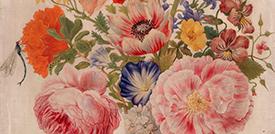
Maria Sibylla Merian, Chinese Vase with Roses, Poppies and Carnations, ca. 1670–1680 (photograph © Staatliche Museen zu Berlin, Kupferstichkabinett / Dietmar Katz)
Maria Sibylla Merian and the Tradition of Flower Illustration
Kupferstichkabinett, Berlin
Matthäikirchplatz, 10785 Berlin, Germany
April 7–July 3, 2017
Städel Museum in Frankfurt
Schaumainkai 63, 60596 Frankfurt am Main, Germany
October 11, 2017–January 14, 2018
Academic conference
University of Amsterdam
ARTIS Library, Plantage Middenlaan 45-45A, 1018 DC Amsterdam, Netherlands
June 7–9, 2017
In commemoration of the three hundredth anniversary of the death of the German-born illustrator and naturalist Maria Sibylla Merian, the Kupferstichkabinett in Berlin (April 7–July 2, 2017) and Städel Museum in Frankfurt (October 11–January 14, 2018) are sponsoring a joint show of approximately 150 of her works on paper and vellum. Known for her exquisite depictions of flowers and insects, Merian had an international reputation in her lifetime. Her illustrated texts include a volume of engravings of flora and fauna she produced while on a scientific expedition to the Dutch colony of Surinam in 1699. As a complement to this exhibition, the University of Amsterdam is sponsoring an academic conference titled “Changing the Nature of Art and Science: Intersections with Maria Sibylla Merian” (June 7–9, 2017), where her contributions to the history of printmaking, natural history, and botanical art will be honored.
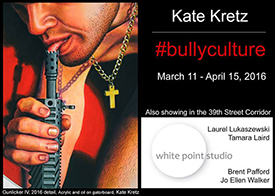
Invitation for Kate Kretz’s #bullyculture
Kate Kretz: #bullyculture
39th Street Gallery and Corridor Exhibition Space
Gateway Arts Center, 3901 Rhode Island Ave, Brentwood, Maryland
March 11–April 15, 2017
#bullyculture represents the first phase of an ambitious in-progress series that Kate Kretz commenced in 2011 and will conclude later this year. In her quest to find the common denominator to all the crimes against women, children, “minorities,” animals, and the earth, she has produced a large corpus of works on paper, sculpture, paintings, textiles, and mixed media. Some of the themes she explores in this series include “trophy hunting, VIP culture and ‘the 1%’, corporate destruction of the earth, rape culture and sexual entitlement, the fetishization of guns and their use for intimidation.” The artist, who has received numerous awards and grants, including the Southeastern College Art Conference’s 2016 award for Outstanding Artistic Achievement and a position on the Fulbright Specialist Roster through 2021, will be giving a lecture on April 1.
Shagha Ariannia: Who Sings the Nation-State?
Vincent Price Art Museum
East Los Angeles College, 1301 Avenida Cesar Chavez, Monterey Park, CA
March 18–June 10, 2017
A little over fifteen years ago, and one week after 9/11, Shagha Ariannia and her family arrived to Los Angeles as migrants from Iran. Ariannia has mined this particularly potent history of travel, place-finding, and identity-in-transit throughout her artistic career by, for example, annotating her family’s photographic archives in a series called What would America/Iran do without Iran/America? (2012). This solo exhibition focuses on a series of works Ariannia has been creating using national anthems from various countries (Iran and the United States included, among many others). In this way she takes seriously the titular question posed by Gayatri Spivak and Judith Butler in their 2007 dialogue Who Sings the Nation-State? As Butler says in that text, in regard to hearing the US national anthem sung in Spanish in the streets of Los Angeles, “The monolingual requirement of the nation surely surfaces in the refusal to hear the anthem sung in Spanish, but it does not make the anthem any less sing-able in that or any other language” (60).
Nina Katchadourian: Curiouser
Blanton Museum of Art
200 E. Martin Luther King Jr. Blvd., Austin, TX
March 12 – June 11, 2017
A few years ago I recall seeing a dozen or so clickbait-y articles written about Nina Katchadourian’s Lavatory Self-Portraits in the Flemish Style, a series in which the artist constructed toilet-paper and neck-pillow costumes during long-haul flights and photographed herself wearing them in the tiny, and poorly lit, spaces of onboard lavatories. This midcareer survey—the artist’s first touring museum exhibition—promises to flesh out Katchadourian’s wide-ranging work. The Flemish lavatory portraits, for example, are only one piece of a larger series of works using the airplane as studio space (Seat Assignment, 2010–ongoing). One of the works on display, and one of her most well-known, is the video Accent Elimination, wherein the artist hired a speech coach to teach her parents (both foreign born) to speak in a “standard” American accent, and, in turn, to teach her how to speak with her parents’ accent. Her collaborations with her family, other artists, international agencies, and even animals are potent reminders that the activity of art is almost never a solitary endeavor, and her interest in quotidian acts of creativity suggests that art can be found anywhere. One just has to know how to look.
May Stevens: Alice in the Garden
Ryan Lee Gallery
515 West 26th Street, New York, New York
February 23–April 8, 2017
May Stevens, a celebrated activist committed to the civil rights, antiwar, and feminist movements, used painting to combat social injustice and to revise women’s history throughout her seventy-year career. The exhibition Alice in the Garden comprises several large-scale paintings depicting Alice Dick Stevens, her elderly mother, during the final years of her life.
From 1983 and 1990, Stevens turned her attention to her mother and producing the five-panel painting Alice in the Garden (1988–89). “The mural-like images confront the viewer with the massive figure of Alice—fleshy, fragile, and vulnerable. In her hands, Alice manipulates flowers—dandelions Stevens had playfully thrown at her during an afternoon visit.”
In a conversation with the art historian Patricia Hills, Stevens explained the importance of Alice as a subject: “For me I think it means I want her [Alice] to be known, even for the individual person that she is, but it also means that I want people like that not to be forgotten. For me she’s not just a single person, because we all know this person. We all know her and we may become her. She’s a problem. As aging is a problem, as illness is a problem, as being a woman who does not fulfill herself is a problem.” (Patricia Hills, May Stevens [San Francisco: Pomegranate, 2005], 45.)
Today May Stevens, now 92, lives with Alzheimer’s disease in a memory-loss facility in New Mexico. She has received numerous awards including ten MacDowell Colony residencies, the Women’s Caucus for Art Lifetime Achievement Award (1990), a Guggenheim fellowship in painting (1986), a National Endowment for the Arts Fellowship in painting (1983), an Andy Warhol Foundation residency (2001), and CAA’s own Distinguished Artist Award for Lifetime Achievement (2001).
Terrains of the Body: Photography from the National Museum of Women in the Arts
Whitechapel Gallery
77-82 Whitechapel High St, London
January 18–April 16, 2017
Featuring over seventeen contemporary artists working across mediums, Terrains of the Body: Photography from the National Museum of Women in the Arts assembles an impressive collection from Washington, DC, for display across the water in London. “By turning their camera to women, including themselves, these artists embrace the female body as a vital medium for storytelling, expressing identity and reflecting individual and collective experience.”
Many works in the display extend the scope of 1970s feminist art, including performance and video. This display celebrates their legacy today. Moving between photography’s ability to document and tell stories, these works present women as creator and subject of their work. Several artists in the exhibition, including Nan Goldin and Daniela Rossell, photograph women in expansive series that appear documentary in nature. Other artists include Marina Abramović, Rineke Dijkstra, Anna Gaskell, Charlotte Gyllenhammar, Candida Höfer, Icelandic Love Corporation, Mwangi Hutter, Kirsten Justesen, Justine Kurland, Nikki S. Lee, Hellen van Meene, Shirin Neshat, Eve Sussman and the Rufus Corporation, Janaina Tschäpe, and Adriana Varejão.
News from the Art and Academic Worlds
posted by Christopher Howard — Mar 29, 2017
Each week CAA News summarizes eight articles, published around the web, that CAA members may find interesting and useful in their professional and creative lives.
Women’s Movement Impacts Spending on Art Supplies
The week before the Women’s March, sales of poster boards in the US were up 33 percent and foam boards by 42 percent versus the same week last year. Sales of easel pads/flip charts also grew, as did tools used to assist in making the poster messages, including paint markers, specialty markers, and permanent markers. (Read more from NPD Group.)
Gender Gap Persists at Largest Museums
When the director of the Metropolitan Museum of Art steps down in June, the top job at the biggest art museum in the US will be up for grabs. A woman faces long odds of landing that job, to judge from a study from the Association of Art Museum Directors. “The Ongoing Gender Gap in Art Museum Directorships” shows that just one of the nation’s thirteen largest museums is led by a woman. (Read more from the New York Times.)
Meet Art Girl Army, a Group of Female Creatives Fighting for Equal Opportunity
When Sydney Lowe invited a few girlfriends over to her small Brooklyn apartment in 2014, she didn’t know she was starting an army. Today she is the founder of Art Girl Army, a fast-growing collective of women creatives—including those who are gender nonconforming, transgender, and genderqueer—who make art, films, graphics, and music. And while they might not be armed with weapons, they certainly have missions. (Read more from Artsy.)
Seeking Grants: More Than Money
The need to succeed at getting grants is a continuing part of faculty life at research institutions. Watching the process leaves some graduate students and postdocs convinced that they want no part of it. The stakes seem so high. But bringing in outside funding is the only way to sustain an independent research-driven career in an academic setting. (Read more from Inside Higher Ed.)
Virtual Reality in the Art-History Classroom
I recently become fascinated with virtual reality and the realism I experience by viewing through a small boxlike device—in this case, Google Cardboard. I wondered if there could be connections made between virtual reality and my art-history survey course for students at Mount Saint Mary College. (Read more from Art History Teaching Resources.)
The American Government Is Searching for Its Own Lost Art
They are not America’s art police. There are no midnight raids, covert surveillance, or undercover operations. Most everything is done through cordial emails, polite phone calls, and, if necessary, civil court. While glamour is not top priority, make no mistake—the United States government wants its art back. (Read more from Atlas Obscura.)
Art Attack: Why Do People Try to Destroy Museum Masterpieces?
On March 18, a man “with no fixed abode” slashed Thomas Gainsborough’s The Morning Walk with a screwdriver at London’s National Gallery. He was quickly detained and the damage appears to be fixable—the paint was cut, but the screwdriver did not pierce the supporting canvas. Conservators are brilliant surgeons, and the scars should be invisible by the time they are done. (Read more from Salon.)
Dealing with Disrupters
As obstructionist protests of controversial speakers spread, some say the future of the trend depends on how colleges and universities respond—namely what, if any, disciplinary action they take against participants. But just what action to take, and when, is tricky business. (Read more from Inside Higher Ed.)
News from the Art and Academic Worlds
posted by Christopher Howard — Mar 15, 2017
Each week CAA News summarizes eight articles, published around the web, that CAA members may find interesting and useful in their professional and creative lives.
Can .art Domain Give the Art Business an Online Boost?
London’s Institute of Contemporary Art adopted the new .art suffix last week, a sign that the art and culture business may be coming to terms with its future in the digital realm. The ICA ditched its fusty ica.org.uk domain for the streamlined and descriptive ica.art, and the move may soon be followed at other prestigious art institutions around the world. (Read more from the Guardian.)
BHQFU on How to Run a Free Art School with the “Worst” Business Model
If there’s one thing that sets US education apart from education in other nations, it’s student debt. For art students with vague graduate degrees that don’t offer much job security, the cost of tuition has left many of them worse off after graduating than they were before becoming a student. What can be done? (Read more from Artspace Magazine.)
What Happens to Whitney Biennial Curators after the Show’s Over?
Inclusion in the Whitney Biennial—the influential and sometimes controversial snapshot of contemporary American art that takes place every two years—has launched or resuscitated many an artist’s career. But those tapped to do the selecting have experienced their own professional transformation, as this year’s organizers Christopher Y. Lew and Mia Locks may well discover. (Read more from Artsy Editorial.)
Trigger Warning: Academic Standards Apply
“I don’t like this whole idea of academic standards. Ever since I was in grade school, they’ve made me feel pressured and stressed out. I think academic standards are bullying. Whenever I deal with them, they bring back all these old bad memories. It’s like PTSD or something.” So declared a student from one of my courses at California State University, Fresno. (Read more from Inside Higher Ed.)
New Travel Ban Still Sows Chaos and Confusion
A long-anticipated executive order restricting travelers from a half-dozen predominantly Muslim countries is likely to bring little certainty to American college campuses. The new order imposes a ninety-day ban on issuance of new visas, including student visas, to citizens of Iran, Libya, Somalia, Sudan, Syria, and Yemen. (Read more from the Chronicle of Higher Education.)
Museums Chart a Response to Political Upheaval
As President-elect Donald J. Trump’s Inauguration Day approached, hundreds of artists, critics, and others asked American museums, galleries, and other institutions to close their doors in protest. They wanted museums to show that they are “places where resistant forms of thinking, seeing, feeling, and acting can be produced,” the organizers wrote in a petition for a J20 Art Strike. (Read more from the New York Times.)
When the Private Sector Funds the Arts
I recently wrote a piece defending the NEA, a grant-making organization that is somehow such a drag on the economy that it is now on the chopping block for the federal 2017 budget. This move makes perfect sense for Donald Trump the businessman, according to GOP enablers, because if the arts and so-called free expression are so worthy, the private sector will step in and fund them. (Read more from the Millions.)
US Embassy Art Scheme Should Survive Trump
The Trump administration is considering cutting federal funding for the arts, among other spending programs, to reduce domestic spending. However, one US cultural initiative appears to be secure—the State Department’s Art in Embassies program, which places works by US artists in embassies and ambassadorial homes around the world. (Read more from the Art Newspaper.)





 George Peter Alexander Healy, Frederic Edwin Church, and Jervis McEntee, The Arch of Titus, 1871. Bequest of Dr. J. Ackerman Coles, 1926. 26.1260
George Peter Alexander Healy, Frederic Edwin Church, and Jervis McEntee, The Arch of Titus, 1871. Bequest of Dr. J. Ackerman Coles, 1926. 26.1260
 Elizabeth Terry Seaks (photograph provided by the Winterthur Museum, Garden, and Library)
Elizabeth Terry Seaks (photograph provided by the Winterthur Museum, Garden, and Library)
 Cordula Grewe
Cordula Grewe
 Jonathan Morgan
Jonathan Morgan
 Jennifer Rissler
Jennifer Rissler
 Connie H. Choi
Connie H. Choi
 Conny Bogaard
Conny Bogaard